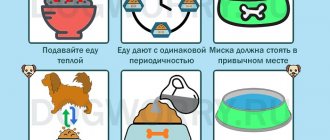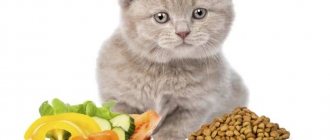Why dogs can't eat pork
Among novice dog breeders, the ban on feeding dogs pork remains popular.
Owners avoid including pork in the diet for the following reasons:
- Eating raw meat or offal can cause infection with diseases such as helmitosis, toxocariasis, rabies and Aujeszky's disease;
- The abundance of fatty foods in the diet increases the cholesterol level in the pet’s blood;
- Eating pork slows down and impairs the animal’s digestion;
- “Heavy” meat provokes intestinal volvulus.
However, painful symptoms are caused by an imbalance of proteins, fats and carbohydrates.
In fact, including fatty acids in your diet is essential for healthy coat growth, circulation and skin repair, especially during the colder months.
Pork meat should be included in your pet’s diet as one of the components, along with cereals, vegetables and dietary meats (veal, rabbit and lamb) and poultry.
In addition, the digestion of pork by the gastrointestinal tract takes up to 12 hours, therefore, in order to avoid indigestion and, as a result, intestinal volvulus, veterinarians recommend increasing the standard break between meals. You should avoid feeding pork every day and do not expose your pet to physical activity for 1.5-2 hours after eating.
What could be the consequences of constantly feeding a dog pork?
If you constantly feed your dog pork meat containing layers of fat and lard, the pet will gradually develop the following pathologies:
- Obesity. A large amount of consumed fat is deposited not only in the subcutaneous tissue, but also on the internal organs, which impairs their functionality.
- Cardiac abnormalities are usually associated with excess weight, as well as increased levels of cholesterol in the blood, which adversely affects the walls and lumen of blood vessels.
- Liver lipidosis is a pathology in which adipose tissue accumulates in the organ. The deviation is irreversible, the functions of the organ are reduced, as a result of which the general condition of the pet gradually worsens.
- Pancreatitis develops due to increased load on the pancreas, as a result of which its enzymatic function increases. When feeding a type of meat that is too fatty, the gland works more intensively, which sooner or later leads to a disruption in the production of enzymes capable of breaking down the components of the feed.
Can dogs have boiled pork?
Eating raw pork meat to a dog often causes infection with infectious diseases and parasites.
To ensure rapid growth and weight gain, meat producers influence the hormonal levels of pigs, which results in suppression of the animals' immune system. For this reason, pigs become carriers of helminths and some infections that can be transmitted to pets when fed raw pork.
To avoid infecting your dog when feeding pork, the meat should be thoroughly cooked.
Some viruses are also resistant to heat treatment. For example, the false rabies virus transmitted by pigs can remain viable at a temperature of 70 ° C for 15 minutes. In this regard, experienced owners recommend boiling pork meat for 40 to 60 minutes, and including it boiled in the pet’s diet.
How to add pork to your pet's diet?
Feeding pork should be no more than twice a week. It is not suitable for a regular basis of the diet. You need to choose meat in trusted stores, where it is subject to control. Before feeding, it must be washed and boiled well. The fat is removed and under no circumstances is it given to the dog.
It is still best to consult a veterinarian before adding it to your diet. If dogs are sick, pork can be harmful. Also, consult whether dogs can have milk and what vegetables and fruits can be given to dogs in order to diversify the menu of your four-legged friend.
Is it possible to give a dog pig ears?
When feeding this type of meat, dogs should not be given pork trachea, offal, pig ears, legs, etc. Instead, it is better to give your pet chicken or beef. This will help avoid parasite infestation.
Can dogs have lard?
Giving lard is strictly contraindicated. Lard contains a large amount of fat. But pork should be given a couple of times a week. This will help enrich your diet with vitamins and microelements.
Can dogs have boiled pork?
It is necessary to cook meat, even after freezing, which does not protect against parasites and infections. Boiled pork can be given to dogs, this will help avoid infection.
Can dogs be given pork skin?
Whether it is possible to give a dog pork skin or pig ears is a complex question. More often the answer will be “no”, since the risk of helminth infection is high.
How to include pork heart in a dog's diet
Heart is included in dog food as a source of protein. Contrary to popular belief, pork heart, like chicken and beef, does not contain fat, as it consists entirely of muscle tissue.
Heart tissue is a rich source of minerals (potassium, magnesium) and iron necessary for healthy muscles and bones. Pork heart is easier to digest compared to beef heart and is considered more dietary. In addition, pork by-products are widely available and cheaper.
The main danger for dogs when consuming pork heart is helminths. Thorough heat treatment will help avoid infection.
When used correctly, pig heart muscle can become a complete source of animal protein and support the harmonious development of the pet during periods of intense training.
What should a dog owner remember?
Having learned about these diseases, any owner should understand why dogs should not eat pork. By the way, sometimes pork can be given to a dog. In winter, animals store fat to maintain temperature. your pet lean pieces of pork once a week At other times, it is allowed to give the heart and stomach of pigs to a dog.
Now many veterinarians are reconsidering their attitude to why pork is harmful to dogs. It is increasingly being said that lean pork is given as part of diets. Pork contains iron, zinc, amino acids, and B-group vitamins. This means that it can be given to dogs.
Knowing why it is impossible, everyone decides for himself and his animal what to give and in what capacity. High-quality lean and cooked meat can be given, but not overused.
Is it possible to give a dog pork skin?
The fattest part of the carcass is the subcutaneous area. The layer of fat in the pork skin area provides thermoregulation. Fearing the development of obesity in pets, dog breeders avoid feeding their pets skin.
Pork skin
At the same time, in the natural environment, the closest relatives of domestic dogs - wolves and wild dogs - eat all parts of the carcass, including the skin. The skin is useful for maintaining healthy joints and skin of your pet. Regular consumption of pork skin as a supplement to the basic diet will help avoid the development of chondrosis and osteoporosis.
A frozen roll made from pork skin, offal and poultry would be an excellent treat for your pet.
It is possible to purchase pork skin at a low price at meat markets, but you should carefully choose the seller and first make sure that you have the necessary sanitary permits.
The effect of foods on the digestive system
Many different foods should not be given to a dog. One of the prohibited foods is pork. As already mentioned, pork is the fattest meat and this is the reason it is prohibited for the canine digestive system.
Interesting: White fluffy dog breeds: description and characteristics
Why you can’t feed a dog pork can be understood by analyzing its negative properties and future consequences.
Pork fat in large volumes is difficult for a dog’s stomach to digest. This fat accumulates in the liver cells and leads to obesity in the dog. No amount of physical activity will help here , because nature itself is inherent in the body’s immunity to such heavy food.
Any meat undergoes pre-sale testing for quality and the absence of parasites. But what is normal for a person can be dangerous for a dog. If pork does not contain diseases or parasites dangerous to humans, then for his friend it may be just the opposite. One of the canine diseases, distemper, occurs as a result of eating pork. You can also become infected with a parasite such as trichinella from this meat. There have been cases of contracting rabies after eating “forbidden” meat.
This is why dogs should not eat meat from domestic pigs or wild boars. Even if you completely exclude pork from your diet, you can still encounter it, for example in dry food. Indeed, expensive dry food contains lean and steamed pork , which undergoes strict quality control and processing.
Can dogs have lard?
Pork lard is a source of triglycerides and vitamins, but is poorly absorbed by the dog’s body. Undigested product accumulates in the liver cells and leads to pet obesity. In this case, the process of deposition occurs initially on the internal organs of the animal and then affects the constitution of the dog.
In addition to damaging the liver of pets, feeding lard can cause problems with the cardiovascular and digestive systems.
Despite the fact that the animal needs fats for hair growth, feeding lard to a domestic predator is highly not recommended. It is preferable to include meat with a fat content of up to 40% in the diet.
Pork is affected by viruses and parasites more often than other types of meat
Since pigs grow and gain weight much faster than all other animals, modern pork producers are aimed at providing the population with a large amount of this product. Stimulating rapid growth led to suppression of the hormonal system of animals and, as a result, a lack of immunity to various diseases.
Pigs are susceptible to diseases such as:
- Helmitiasis (worms and parasites that affect the digestive tract).
- Toxocariasis (the subspecies of these worms itself is not so scary. What’s scary is the larvae that they lay inside the animal’s body. These larvae wander throughout the body and literally eat all the internal organs from the inside).
- Rabies (the disease develops very quickly and leads to the inevitable death of the animal).
- Tapeworm (a very rare but dangerous disease. It affects the central nervous system and leads to the death of the animal. Initial symptoms are weight loss).
The likelihood of your pet contracting these diseases when feeding raw pork from a sick animal is quite high. That is why it is imperative to buy pork from a trusted producer. You must be sure that the meat has undergone strict veterinary control before reaching the counter.
Can dogs eat pork lung?
Pig lungs are given to dogs as a treat. The lungs are composed primarily of connective tissue and are not digested by the canine digestive system. Due to the structural features of the lung tissue, this type of by-product does not benefit the animal’s body; moreover, due to its low digestibility, the lungs often cause vomiting.
Due to difficulties in digestion, pig lungs are given to pets in limited quantities and only in combination with other protein-rich offal or with poultry or beef.
It is recommended to prepare a meat mix from boiled lungs, liver and heart and mix them with porridge for complete nutrition for the dog. Kidneys should not be added to a meat mix with lungs.
Also, you should not feed your pet this offal raw. Pig lungs are elastic, and if eaten whole the animal may choke. The lungs are given to the pet boiled or dried.
The by-product contains a wide range of useful substances to strengthen the animal's respiratory system, including:
- trace elements (sodium, magnesium, iron, potassium, phosphorus, iodine);
- vitamins (C, A and group B).
However, lung feeding should be done with caution and prior veterinary consultation for dogs susceptible to allergic reactions.
Dog diet
How the puppy that appears in the house develops and grows depends on what it is fed. Particular attention is paid to nutrition in the first year of a dog’s life. If the puppy does not receive the substances it needs, then problems may arise , which will also affect its health. Fur, teeth, skeleton, and claws - all this is formed as a result of proper nutrition.
Interesting: Albino Dobermann - a good friend or a failed experiment
A puppy is the same child, only a dog, and therefore they feed it approximately the same (in terms of feeding frequency):
- after he began to eat on his own, that is, from the age of one and a half months to two, the puppy is fed every three hours;
- from two to three months the number of feedings begins to decrease from 6 to 5;
- then every two months the number of feedings decreases: at 4-5 months it is already 4 times, and at 6-7 months - 3 times a day;
- after the dog is one year old (you can even a couple of months later), feeding is carried out twice a day.
It is important not only the correct hourly feeding, but the correct diet.
Gradually, about once a week, you can add raw fish to your diet. It is better to give sea fish, as it is healthier and has fewer small bones. In addition, the risk of contracting worms comes from river fish.
A misconception is: “give the dog some milk.” Yes, milk contains both calcium and phosphorus. But milk also causes digestive problems, and not just in dogs. And phosphorus is absorbed from sea fish.
It might seem strange, but dogs can and should be given vegetables and fruits. At first, vegetables are given pureed , accustoming them to them from childhood. Vegetables and fruits contain many vitamins and also help the animal brush its teeth. When a dog chews a fruit or vegetable, it uses it to remove plaque from the teeth.
And of course, meat, as a high protein source, should be on the menu. Even if pork is completely excluded from the dog menu, beef and lamb should still be cooked.
Good nutrition is important to a dog's health. You should know that her digestive system features differ from humans. It is the dog's digestive process that does not allow him to be given pork.
Is it possible to give a dog pork kidneys?
Kidneys are rightfully considered the most dietary treat for dogs, as they are digested better than other by-products and the fat content in kidney tissue is less than 3%. In addition, they contain a full range of essential minerals and trace elements, and are also rich in selenium and vitamins A, D and group B. The delicacy improves the process of hematopoiesis and saturates the animal’s body with amino acids.
Pig kidneys for dogs
It is noteworthy that among all types of this by-product, pork kidneys are the most useful, since they are easier to digest than beef kidneys, and are more saturated with nutrients compared to lamb and poultry kidneys.
Pork kidneys have a sharp, specific smell; for this reason, they are rarely used in cooking. When feeding dogs, the intense aroma attracts the pet and increases appetite.
The offal is given frozen, since the organ consists of 80% water - during heat treatment, the kidneys lose most of their volume and are more difficult to digest.
How to feed your dog pork
To avoid health problems for your dog and diversify his diet, you should follow a number of rules:
- Unlike other types of meat, it is not recommended to serve pork raw, only boiled for at least 45 minutes;
- Pork meat even in its raw form is considered heavy food for an animal, especially after heat treatment, during which the digestibility of the product is reduced by 40%, so it is not advisable to feed your pet pork every day;
- for feeding a dog, it is preferable to choose less fatty meat, with layers of connective tissue, as this will have a beneficial effect on intestinal function;
- to maintain the balance of BJU in the dog’s diet, pork and its by-products should be mixed with boiled vegetables, cereals, other dietary meat or dry food;
- meat should be purchased only from reliable retail chains or from a certified manufacturer to avoid transmitting diseases to your pet through food;
- It is advisable to introduce pork into a dog’s diet in the autumn-winter period, and immediately after feeding, give the dog a quiet rest and avoid physical activity for 2 hours; however, in order to avoid the development of obesity, we do not recommend completely eliminating exercise.
Should I feed the puppies?
Up to 1.5-2 months, puppies are naturally fed and receive all the nutrients from their mother’s milk. From about 1 month, you can begin to gradually introduce complementary foods, starting with lean meat.
Like a small child, a puppy’s gastrointestinal tract has not yet fully formed, and even a single meal of fatty food can lead to stomach problems, bloating and diarrhea.
Therefore, if you give fat, it should be fish oil with vitamins A and D, to prevent the development of rickets, and only in the autumn-winter period. From 3-4 months, you can only introduce little by little pork skin containing calcium and gelatin, useful for strengthening bones, and be sure to monitor the reaction of the little pet’s body.
Starting from 4-6 months, lard can be given in strictly limited quantities and only to puppies that are lagging in development or underweight .










